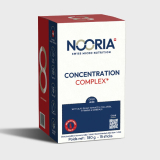From DR. DIMITRIOS SAMARAS (President of Nooria Scientific Advisory Board)
published in February 2025

A Devastating Epidemic
Undoubtedly, the obesity epidemic is one of the greatest challenges to public health, pension financing for future generations, and the economies of most developed countries. Its scale is unprecedented, with one-third of the world’s population classified as overweightor obese—affecting approximately 2.1 billion people (1). Even more concerning, these figures date back over a decade, meaning the current numbers are likely even higher.
Obesity: So What?
For at least two decades, the scientific community has highlighted what is now referred to as the “pandemic of morbidity.” Whilemedical advancements in the past century have significantly extended life expectancy, they have also led to an increase in years livedwith disability, chronic illnesses, and soaring healthcare costs.
Obesity plays a central role in this phenomenon, as it is a causal factor in nearly all chronic diseases. In fact, being obese at age 50 quadruples the risk of hospitalization for a cardiovascular disease in the following years compared to the general population (2). Even more strikingly, obesity’s impact on an individual’s quality of life can be more detrimental than well-known addictions such as alcohol and smoking (3).

Weight Management Tools
For decades, voluntary calorie restriction has been the cornerstone of weight loss. Weight loss professionals have strongly advocatedfor it, while patients have struggled, often achieving only temporary results. The likelihood of maintaining weight loss achievedthrough restrictive dieting is at best small (4). This leads to the phenomenon of weight cycling, where individuals jump from one dietto another. The negative impact of weight cycling on body composition, muscle mass, and basal metabolism explains why frequentdieting ultimately increases the likelihood of becoming obese(5).
This is where new tools come into play. Many readers are likely familiar with GLP-1 receptor agonists, a new class of antidiabeticdrugs designed to reduce hunger and promote a longer-lasting feeling of fullness. These medications have demonstrated a strongsafety profile, with no known long-term side effects over the two decades they have been used in diabetic patients. But do they work? Yes, they do, with a realistic expectation of a 10% reduction in initial body weight (6). However, is this weight loss sustainable? That depends.

Social media is filled with testimonials of individuals rapidly regaining weight after discontinuing these drugs due to reboundhunger. The explanation is simple: these medications can only serve as a supplementary aid in the overall process of change. Sustainable weight loss requires changes in habits, respect for the body’s metabolic rhythms, consideration of individual preferences, and, above all, an approach that allows for food-related pleasure. Most individuals who regain weight after stopping GLP-1 agonistsrelied solely on the drug’s effects without making any meaningful lifestyle changes. In other words, if you rely only on the medication without making further adjustments, your weight loss will likely be temporary, artificial. However, if you developrealistic, sustainable habits, optimize your diet, and respect your natural need for food-related enjoyment, the outcome will bedifferent. This is where weight management supplements, natural weight loss aids, and metabolism booster supplements may play a valuable role.
Nooria Supplements for Weight Management: natural supplements and not just daily vitamins
True to our mission of creating high-quality, organic supplements with clinically significant effects, Nooria’s Contour®andMetanoor® are formulated with a blend of nutraceuticals known to support metabolism, glucose control, and, most importantly,decrease insulin resistance.
Insulin resistance is widely considered a prediabetic state in which the pancreas overproduces insulin to maintain normal bloodglucose levels. However, this comes at a cost: increased fat storage. Insulin is a lipogenic hormone, meaning it promotes fat accumulation, particularly visceral fat, which further exacerbates insulin resistance. This creates a vicious cycle—greater insulinresistance leads to easier fat accumulation, which, in turn, worsens insulin resistance and perpetuates metabolic decline. For thisreason, insulin resistance is believed to play a central role in obesity maintenance.

Nooria’s weight management supplements aim to interrupt this key mechanism in obesity’s pathophysiology and enhance metabolicefficiency. Additional benefits may include improved gut health through targeted probiotics and prebiotics, as well as ingredientswith antioxidant, anti-inflammatory, and lipid-lowering properties. However, the effectiveness of these quality supplements dependson an individual’s overall nutritional strategy, which should always be assessed and guided by a nutrition specialist.
By integrating science-backed strategies with sustainable lifestyle changes, individuals can move beyond temporary weight losssolutions and embrace long-term metabolic health.
References:
1. Ng, M., et al. “Global, Regional, and National Prevalence of Overweight and Obesity in Children and Adults During 1980-2013: A Systematic Analysis for the Global Burden of Disease Study 2013.” The Lancet, vol. 384, no. 9945, 30 Aug. 2014, pp. 766-81. doi:10.1016/S0140-6736(14)60460-8.
2. Yan, L. L., et al. “Midlife Body Mass Index and Hospitalization and Mortality in Older Age.” JAMA, vol. 295, no. 2, 2006, pp. 190-98.
3. Sturm, Roland. “The Effects of Obesity, Smoking, and Drinking on Medical Problems and Costs.” Health Affairs, vol. 21, no. 2, 2002, pp. 245-53.
4. Langeveld, Marjolein, and J. Hans DeVries. “The Long-Term Effect of Energy Restricted Diets for Treating Obesity.” Obesity, vol. 23, no. 8, Aug. 2015, pp. 1529-38. doi:10.1002/oby.21146.
5. Pietiläinen, Kirsi H., et al. “Does Dieting Make You Fat? A Twin Study.” International Journal of Obesity, vol. 36, no. 3, 2012, pp. 456-64.
6. Ghusn, W., et al. “Weight Loss Outcomes Associated with Semaglutide Treatment for Patients with Overweight or Obesity.” JAMA Network Open, vol. 5, 2022, https://doi.org/10.1001/jamanetworkopen.2022.31982.



